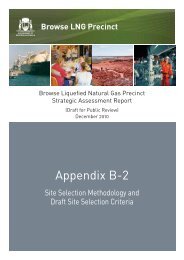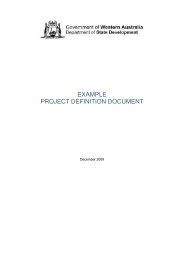Browse LNG Precinct - Public Information Booklet - Department of ...
Browse LNG Precinct - Public Information Booklet - Department of ...
Browse LNG Precinct - Public Information Booklet - Department of ...
You also want an ePaper? Increase the reach of your titles
YUMPU automatically turns print PDFs into web optimized ePapers that Google loves.
<strong>Public</strong> <strong>Information</strong> <strong>Booklet</strong><br />
Question ñ With respect to impact on the coast you indicated 40 hectares <strong>of</strong> vine<br />
thicket would be impacted to the south <strong>of</strong> James Price Point. How big is the coastal<br />
impact overall?<br />
The actual area <strong>of</strong> disturbed coast is dependent on the final location <strong>of</strong> the site. It has<br />
been estimated to be approximately 1.3 to 1.5 kilometres <strong>of</strong> coastal disturbance. This<br />
area includes the shoreline, coastal dunes and up to 40 to 60 hectares <strong>of</strong> vine thicket (for<br />
a southern site). The pipeline corridor may also require some vine thicket clearing, and<br />
this will be rehabilitated once the pipeline is installed.<br />
Vine thickets occur in many locations along the Dampier Peninsula coastline. The 40-60<br />
hectares represents about 10-15% <strong>of</strong> the vine thickets that are occur in the James Price<br />
Point area.<br />
5.4. Marine Issues<br />
Construction (Dredging and Blasting)<br />
Question ñ How much dredging is necessary?<br />
Preliminary estimates indicate a total dredging volume for a southern James Price Point<br />
site to be in the order <strong>of</strong> 6 to 8 million cubic metres or less than half the volume <strong>of</strong> the<br />
northern site. It is estimated about 10% <strong>of</strong> this material would need to be blasted to<br />
enable removal.<br />
Total dredging volume for a northern James Price Point location would be approximately<br />
15 to 20 million cubic metres. Based on the preliminary understanding <strong>of</strong> the seabed<br />
material, about half <strong>of</strong> this (50%) potentially needs to be blasted to enable removal. This<br />
estimated blast volume is about 12 times the required blasting for the southern site.<br />
Question - How <strong>of</strong>ten will repeat or maintenance dredging be required?<br />
Currently there is insufficient information to make an assessment on maintenance<br />
dredging requirements. Once a better understanding <strong>of</strong> seabed properties and the<br />
movement <strong>of</strong> sand in the area is understood from planned studies and sampling<br />
programs a scientifically based estimate can be made on the need for repeat or<br />
maintenance dredging. However based on pr<strong>of</strong>essional experience it is anticipated to be<br />
around every 5-10 years.<br />
Question ñ With respect to dredge sediment, how long will it be until the sediment<br />
settles down and how do you intend to control and contain the dredge plume?<br />
Once the dredge stops operating the water is typically back to normal within a few hours<br />
and usually it isnít possible to measure any plume after 12 to 24 hours. This time is likely<br />
to vary based on weather conditions; current flow; type <strong>of</strong> material being dredged and the<br />
dredge technique being used.<br />
As part <strong>of</strong> the environmental impact assessment and engineering design work more<br />
information will be collected on the material to be dredged; currents and waves in the<br />
area; water depth; and seabed characteristics to better understand what is likely to occur.<br />
This then enables the selection <strong>of</strong> the type <strong>of</strong> dredging technique that can used and with<br />
5279225 59









